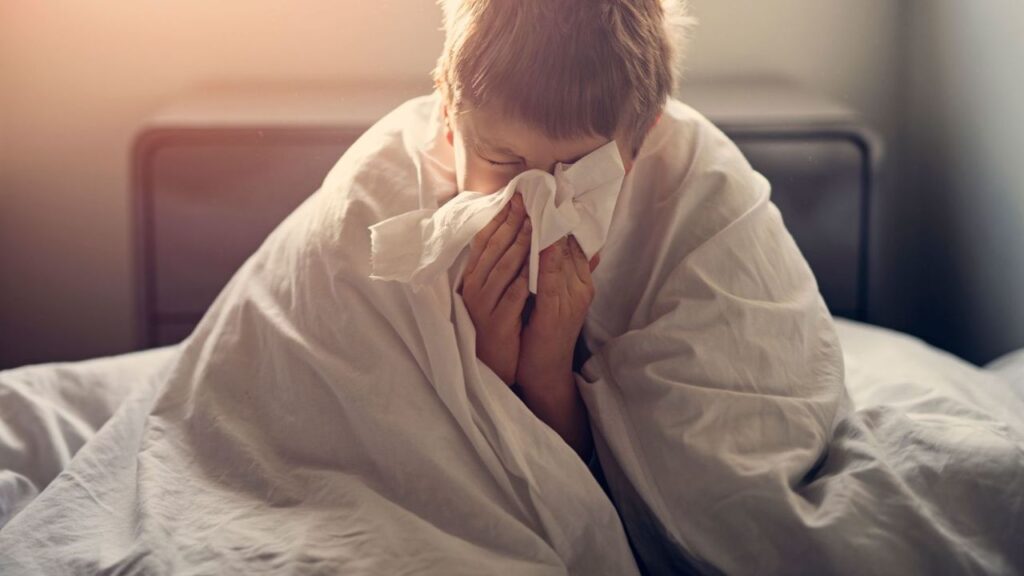According to experts in infectious diseases, children who have coughs that last for weeks may have a form of walking pneumonia that has been on the rise in the US this year and may require a different antibiotic regimen to cure.
According to Dr. Buddy Creech, a pediatric infectious disease expert at Vanderbilt University Medical Center, “it’s very much been on our radar since early summer, when we started to see a remarkable increase in the number of kids with pneumonia who seemed to have this particular type of pneumonia.”
According to Creech, four pediatricians from the Nashville region contacted him the same August day to inquire as to why so many children were coughing during the summer. He claims that these physicians sought guidance since amoxicillin, their preferred medication for pneumonia, didn’t appear to be effective in these situations.
The US Centers for Disease Control and Prevention issued a bulletin this week warning parents and physicians about the increase in pneumonia infections this year, especially among preschool-aged children. The illness is caused by microscopic Mycoplasma pneumoniae bacteria.
The most recent addition to the increasing list of lung illnesses that are keeping physicians on their toes this fall is Mycoplasma pneumonia. In some parts of the United States, the number of instances of respiratory syncytial virus, or RSV, and whooping cough, often known as pertussis, which also causes a persistent cough, has increased fivefold since this time last year.
Mycoplasma testing has been challenging in the past. It is not a type of germ that thrives in a Petri dish, which is the conventional method of testing for bacterial infections, albeit a sluggish one.
Creech claims that more accurate and timely detection of these microorganisms is now possible because to improved diagnostic procedures. Doctors must use these new tests to get the correct diagnosis because there are a lot of pathogens causing children to cough this fall, he said.
“We must use these diagnostic tests that can direct treatment at this precise moment,” he stated.
According to the CDC, it’s critical to be aware of the Mycoplasma trend because children’s first-line medications like amoxicillin and penicillin don’t eradicate this kind of bacterium. However, additional medicines like azithromycin can typically be used to treat the illness.
The CDC, which tracks test results from commercial laboratories and discharge data from a network of hospitals, reports that the percentage of children aged 2–4 who were admitted to the emergency room (ER) for pneumonia and tested positive for Mycoplasma increased sevenfold, from 1% in April 2024 to 7.2% in early October. Over the same period, diagnoses in older children increased from 3.6% to 7.4%, a double increase.
According to the CDC, Mycoplasma instances are still high even though they appear to have peaked in mid-August. According to Creech, they should start to taper off later in the fall after remaining high for another month or so.
Lungs with Mycoplasma infections may appear hazy or “white lung” on an X-ray.
China, Denmark, and France all reported rises in pediatric cases of this type of pneumonia last year.
Dr. Geoffrey Weinberg, a pediatric infectious disease specialist at the University of Rochester Medical Center, stated that there are likely three or more reasons for the increase in cases.
One of these is that Mycoplasma infection rates are reverting to their pre-Covid-19 levels.
Weinberg stated, “It seems very dramatic now, but it’s more because just about everything else went down during the peak of the Covid pandemic.” “However, the actual nationwide rates are not all that different from what they were prior to 2019.”
The second reason is that some years are worse than others since most infections cycle. According to Creech, doctors often observe increases in Mycoplasma pneumonia every three to seven years as patients become less immune to the virus.
Weinberg stated, “There are times when you just have a bad year and then you don’t notice it for a while, and now we’re getting it more.” The surge may seem considerably greater if there are numerous cases after there were none at all, he continued.
The third reason could be that this infection is simply being detected more frequently because doctors now have more sophisticated testing, known as multiplex tests, that can simultaneously look for several kinds of bacteria and viruses.
The bacteria Mycoplasma pneumoniae spreads by way of respiratory droplets. According to the CDC, people contract them by being close to someone else’s coughs and sneezes. Because of this, this kind of pneumonia spreads easily in crowded places like nursing homes, college residence halls, and schools.
These bacteria are also problematic since they can remain in the body for one to four weeks before they cause illness. A person typically has little recollection of what they may have been exposed to by the time symptoms appear.
Mycoplasma infections typically begin with chills, a low temperature, a sore throat, and a headache. The phrase “walking pneumonia” refers to the fact that people can move around even while they feel poorly.
Usually, the cough is dry and devoid of phlegm. Over the course of two to three weeks, it begins softly and then rises until it is nearly constant.
Not every person infected with Mycoplasma will require therapy. Up to 75% of children and young people will recover without treatment, according to Weinberg.
But occasionally, the infection will make patients very sick and worsen pre-existing illnesses like asthma.
These bacteria are rarely able to leave the lungs. They have the ability to infect the brain and spinal cord lining in the central nervous system. Additionally, the germs can infect the nerves that control the legs, bladder, and eyes. Coughing may never occur in certain patients.
